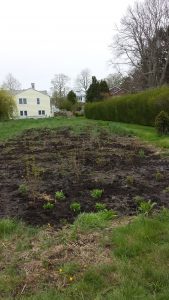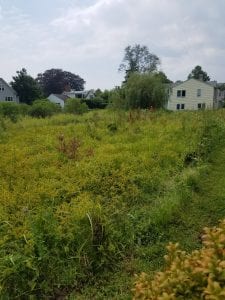With a CLEAR webinar on SLAMM (Sea level affecting marsh migration) this week by Emily Wilson (UConn CLEAR) and David Kozak (CT DEEP), it is timely to provide an update on the marsh migration buffer we’ve been developing in Stonington Borough.
A small parcel of land was donated to Avalonia Land Conservancy (ALC) and added to the Dodge Paddock Beal Preserve. This parcel was a cultivated garden at the time of donation several years ago.
With migration of the nearby marsh in mind, CT Sea Grant teamed up with ALC and applied for and received a grant from the Long Island Sound Futures Fund. Led by Preserve Steward, Beth Sullivan, cultivated plants were removed by numerous groups including local garden clubs and the area prepared for native planting (see UConn CLEAR Blog October 2018). Last year at this time, we had sown coastal grass seeds and covered the area with straw for the winter months.
This past spring, we were happy to see that the black plastic laid down during the summer of 2018 had killed much of the seed bank, and we didn’t have too many weeds and vegetables popping up. A team of intrepid volunteers dug hole after hole for the many native trees, shrubs and perennials that were purchased for the site. We specifically chose numerous plants with some salt spray or soil salt tolerance for planting in the areas closest to the marsh and most likely to be first impacted by marsh migration. Plants such as beach plum, bayberry, serviceberries and big bluestem are natives with some salt tolerance. The buffer filled in well over the summer months with plenty of rain to help the plants get established. With a bit of weeding and trimming around the plantings, the buffer is ready for winter, and hopefully, no serious flood events.
We will be monitoring this area for the next several years looking at soils, plant cover, and watching out for invasive plants. With several permanent metal stakes in the ground, we can consistently take photographs from the same locations each year and monitor changes over time. As part of our education efforts at the site, engraved plant labels were purchased and put in by the native plants for easy identification by visitors to the area. Find out more about this site and directions to visit at https://avalonia.org/preserves/dodge-paddock-beal-preserve/.

The buffer in late August 2019
